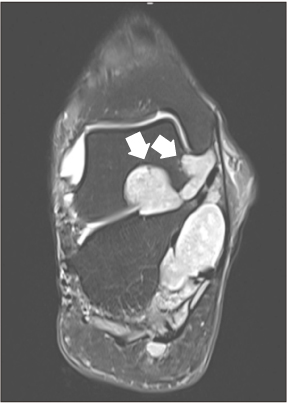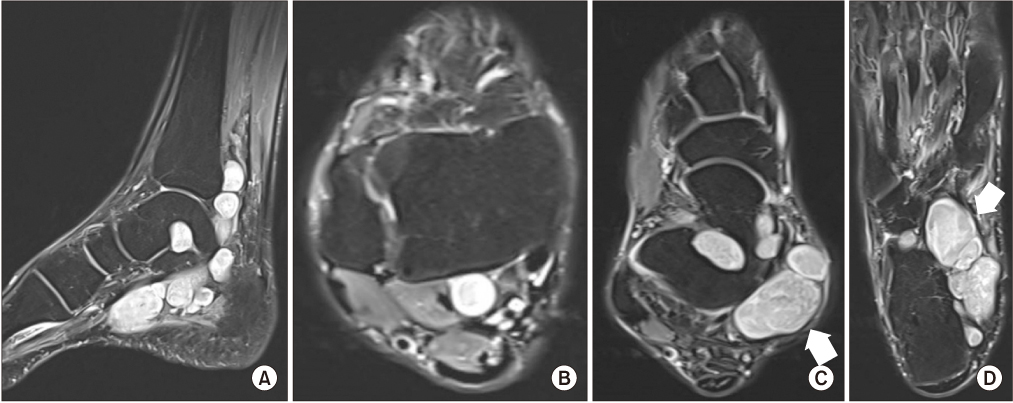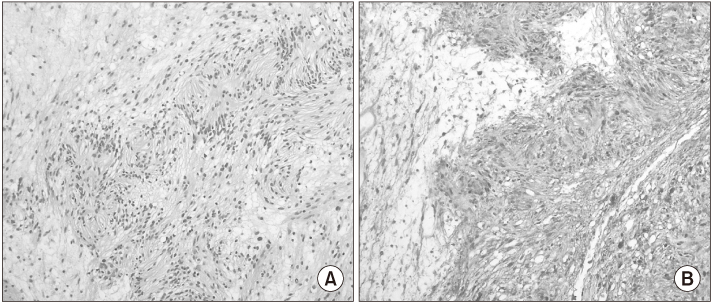J Korean Orthop Assoc.
2019 Feb;54(1):84-89. 10.4055/jkoa.2019.54.1.84.
Recurred Plexiform Schwannoma of the Foot and Ankle
- Affiliations
-
- 1Department of Orthopaedic Surgery, Inje University Sanggye Paik Hospital, Seoul, Korea. orthoman@paik.ac.kr
- KMID: 2438972
- DOI: http://doi.org/10.4055/jkoa.2019.54.1.84
Abstract
- Schwannomas are benign neoplasms with a Schwann cell origin. A plexiform schwannoma is a rare variant of a schwannoma with a plexiform or multinodular growth pattern. The condition occurs mostly as a solitary lesion in the skin or subcutaneous tissue, or uncommonly located in the deep soft tissue. We report a rare case of recurred multiple plexiform schwannomas arising from the posterior tibial nerve and its branch, which was located in a deep anatomic location and accompanied by a bony deformity.
Keyword
MeSH Terms
Figure
Reference
-
1. Ozdemir O, Ozsoy MH, Kurt C, Coskunol E, Calli I. Schwannomas of the hand and wrist: long-term results and review of the literature. J Orthop Surg (Hong Kong). 2005; 13:267–272.
Article2. Li XN, Cui JL, Christopasak SP, Kumar A, Peng ZG. Multiple plexiform schwannomas in the plantar aspect of the foot: case report and literature review. BMC Musculoskelet Disord. 2014; 15:342.
Article3. Hirose T, Scheithauer BW, Sano T. Giant plexiform schwannoma: a report of two cases with soft tissue and visceral involvement. Mod Pathol. 1997; 10:1075–1081.4. Agaram NP, Prakash S, Antonescu CR. Deep-seated plexiform schwannoma: a pathologic study of 16 cases and comparative analysis with the superficial variety. Am J Surg Pathol. 2005; 29:1042–1048.5. Mohammed SA, Pressman MM, Schmidt B, Babu N. Case presentations and review of plexiform schwannoma in the foot. J Foot Ankle Surg. 2014; 53:179–185.
Article6. Harkin JH, Arrington JH, Reed RJ. Benign plexiform schwannoma, a lesion distinct from plexiform neurofibroma. J Neuropathol Exp Neurol. 1978; 37:622.
Article7. Lee KH, Kim YS, Jeong CH, et al. Plexiform neurilemmoma unassociated with neurofibromatosis - 2 cases report - . J Korean Bone Joint Tumor Soc. 2005; 11:82–87.8. Jacobson JM, Felder JM 3rd, Pedroso F, Steinberg JS. Plexiform schwannoma of the foot: a review of the literature and case report. J Foot Ankle Surg. 2011; 50:68–73.
Article9. Nishio J, Mori S, Nabeshima K, Naito M. Successful enucleation of large multinodular/plexiform schwannoma of the foot and ankle. Springerplus. 2015; 17:260.
Article10. Yamada K, Harada M, Kunitoku N, Goto S, Kochi M, Ushio Y. MR imaging features of a scalp plexiform schwannoma. AJNR Am J Neuroradiol. 2004; 25:291–294.







